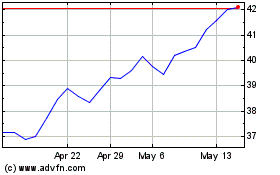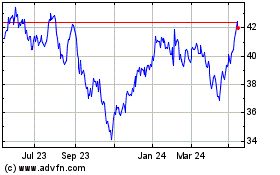QIAGEN Releases New Pandemic Influenza A/H1N1 Detection Kit
September 09 2009 - 11:00PM
Business Wire
QIAGEN (NASDAQ: QGEN; Frankfurt, Prime Standard: QIA), today
announced both the launch of a new Influenza A/H1N1 test and
several updates to its activities in providing solutions for the
global surveillance of the swine flu pandemic. QIAGEN’s new kit
enables both the highly sensitive and specific detection of the
novel Influenza A/H1N1, the virus that causes “swine flu”, as well
as of all other known Influenza A and B virus strains. The new test
kit is a significant addition to QIAGEN’s existing portfolio of
products for H1N1 screening and surveillance. It has been designed
for use by governments and public health institutions as part of
the efforts to identify and control outbreaks of pandemic A/H1N1
Influenza.
The new artus Influenza/H1 RG/LC RT-PCR Kit* provides highly
accurate results in approximately 40 minutes. This is unlike many
current molecular solutions and most antigen-based H1N1 tests,
which can either take up to several hours to produce results or, in
the case of rapid protein-based tests, have been found to have a
low sensitivity in detecting the virus. In addition, QIAGEN’s new
kit can also detect infections with other known Influenza A and B
strains likely to emerge and disseminate in the population during
the upcoming flu season. The rapid turn around time of the
company’s new test can result in faster reporting of results which
plays a key factor in monitoring and controlling outbreaks.
Designed for use with QIAGEN’s automated sample and assay
technologies such as the thermo cycler Rotor-Gene Q, the test is
also compatible with certain other platforms used in laboratories
worldwide, allowing labs to quickly adopt and run it on existing
instruments and without the need for additional training.
“With QIAGEN’s new test and our existing solutions to support
Tamiflu/Oseltamivir resistance testing, we offer healthcare
professionals powerful tools not only to quickly and reliably
detect the origin of flu-like symptoms in patients, but also to
profile the pathogen and thus to rapidly take the necessary actions
to control an outbreak,” said Peer Schatz, CEO of QIAGEN. “In the
light of the upcoming flu season and the likely emergence and
dissemination of other Influenza A and B strains, these
capabilities are vital to effectively fight the further
dissemination and the effects of the H1N1 pandemic.”
QIAGEN provides a broad portfolio of solutions for the
surveillance of the H1N1 pandemic. These include two real time
PCR-based screening tests, a test which detects multiple different
pathogens in one single run (so called “multiplex”), and protocols
for resistance testing. The company’s solutions include individual
sample preparation reagents, enzymes and instrumentation used by
labs in testing protocols recommended by international health
authorities, including the WHO and the U.S. Centers for Disease
Control and Prevention (CDC). This portfolio has become a key
contributor to the worldwide efforts to contain the H1N1
pandemic.
In addition, QIAGEN provided further updates on its recent
activities in the area of swine flu monitoring:
- During the last few weeks QIAGEN
has entered into further, significant supply agreements for
consumables and instruments with public health authorities in
Europe, Asia, Latin America and other regions. This adds to a large
presence already built in the first half of 2009.
- The first customer to order lots
of QIAGEN’s new artus Influenza/H1 RG/LC RT-PCR Kit is the
government of Saudi Arabia. The government is evaluating the
possibility of implementing the screening solution in time to help
contain the spread of the virus during the upcoming Mekka
pilgrimage.
- The CDC’s protocol for swine flu
testing which has recently obtained Emergency Use Authorization by
the US FDA includes QIAGEN components. The CDC protocol has now
been adopted for the surveillance of swine flu infections in U.S.
troops world-wide.
- Additionally, a test protocol
for evaluating Influenza A/H1N1 variations is being widely adopted
for H1N1 resistance testing against Tamiflu/Oseltamivir. This
protocol is based on QIAGEN’s proprietary “Pyrosequencing” assay
technology as well as the company’s sample preparation
technologies. QIAGEN is seeing significant demand for these
solutions as they add significant value as secondary, resistance
testing on samples that have been found positive using screening
tests. This second line testing is increasingly being added to the
front line screening efforts.
QIAGEN had rapidly responded to the initial Influenza A/H1N1
outbreak in April 2009 by quickly validating the ability of its
already-available influenza detection technology platforms to
identify H1N1 as part of the test’s general Influenza A detection
capabilities and has subsequently added a range of additional
solutions to help in disease surveillance and management. The rapid
support for the current pandemic builds on QIAGEN’s experiences
from previous major outbreaks of infectious diseases: QIAGEN is the
leading provider of Avian Flu (H5N1) molecular detection tools
worldwide and also developed the first test for the detection of
SARS. Public health institutions and more than 80 reference
laboratories around the globe use the company's molecular tests and
testing components for surveillance and research of these viral
infections. Worldwide, QIAGEN has the broadest portfolio of
molecular screening solutions for viral infectious diseases.
* The test kit is available in the United States for research
use only. It has not been cleared or approved by authorities
including the United States Food and Drug Administration or any
other regulatory agency in the United States, or under the European
IVD Directive, for human diagnostic or other clinical use, and is
not intended and should not be used for human diagnostic or any
other clinical purposes.
About Swine Flu:
Swine flu (swine influenza) is a highly contagious respiratory
disease of pigs, caused by one of several swine Influenza A
viruses. Since pigs can be infected with more than one virus type
at a time, genes of several viruses from various sources (including
humans) can mix, allowing the swine influenza viruses to cross the
species barrier and eventually cause disease in humans. The
clinical symptoms in humans are similar to seasonal influenza and
other acute upper respiratory tract infections, in some cases
leading to severe pneumonia and resulting in death. However, since
mild or asymptomatic cases may have gone unrecognized, the true
extent of this disease among humans is still unknown. Currently,
there is no human vaccine on the market which protects against
swine influenza. Antiviral drugs are available in many countries.
More information on the swine flu is available on www.who.int.
About QIAGEN:
QIAGEN N.V., a Netherlands holding company, is the
leading global provider of sample and assay technologies.
Sample technologies are used to isolate and process DNA, RNA
and proteins from biological samples such as blood or
tissue. Assay technologies are used to make such isolated
biomolecules visible. QIAGEN has developed and markets more than
500 sample and assay products as well as automated solutions for
such consumables. The company provides its products to
molecular diagnostics laboratories, academic researchers,
pharmaceutical and biotechnology companies, and applied
testing customers for purposes such as forensics, animal
or food testing and pharmaceutical process control. QIAGEN's
assay technologies include one of the broadest panels of molecular
diagnostic tests available worldwide. This panel includes the
digene HPV Test, which is regarded as the "gold standard" in
testing for high-risk types of human papillomavirus (HPV), the
primary cause of cervical cancer. QIAGEN employs more than 3,150
people in over 30 locations worldwide. Further information about
QIAGEN can be found at http://www.qiagen.com/.
Statements contained in this release that are not historical
facts are forward-looking statements, including statements about
our products, markets, strategy and operating results. Such
statements are based on current expectations that involve risks and
uncertainties including, but not limited to, those associated with:
management of growth and international operations (including
currency fluctuations and logistics), variability of our operating
results, commercial development of our markets (including applied
testing, clinical and academic research, proteomics, women’s
health/HPV testing and molecular diagnostics), our relationships
with customers, suppliers and strategic partners, competition,
changes in technology, fluctuations in demand, regulatory
requirements, identifying, developing and producing integrated
products differentiated from our competitors' products, market
acceptance of our products, and integration of acquired
technologies and businesses. For further information, refer to our
filings with the SEC, including our latest Form 20-F. Information
in this release is as of the date of the release, and we undertake
no duty to update this information unless required by law.
###
Qiagen NV (TG:QIA)
Historical Stock Chart
From Jun 2024 to Jul 2024

Qiagen NV (TG:QIA)
Historical Stock Chart
From Jul 2023 to Jul 2024
